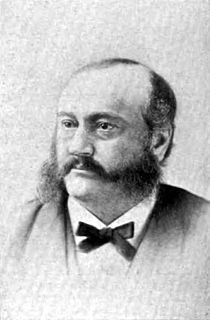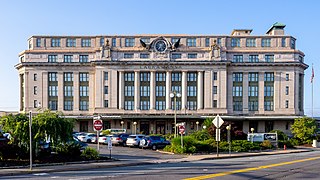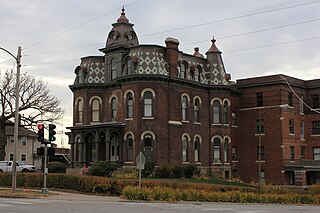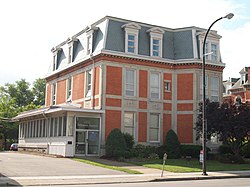
Henry Hobson Richardson was an American architect, best known for his work in a style that became known as Richardsonian Romanesque. Along with Louis Sullivan and Frank Lloyd Wright, Richardson is one of "the recognized trinity of American architecture".

Theodore Roosevelt Inaugural National Historic Site preserves the Ansley Wilcox House, at 641 Delaware Avenue in Buffalo, New York. Here, after the assassination of William McKinley, Theodore Roosevelt took the oath of office as President of the United States on September 14, 1901. A New York historical marker outside the house indicates that it was the site of Theodore Roosevelt's Inauguration.

The New York State Capitol, the seat of the New York State government, is located in Albany, the capital city of the U.S. state of New York. The capitol building is part of the Empire State Plaza complex on State Street in Capitol Park. Housing the New York State Legislature, the building was completed in 1899 at a cost of US$25 million, making it the most expensive government building of its time. It was listed on the National Register of Historic Places in 1971, then included as a contributing property when the Lafayette Park Historic District was listed in 1978. The New York State Capitol was declared a National Historic Landmark in 1979.

The Richardson Olmsted Campus in Buffalo, New York, United States, was designated a National Historic Landmark in 1986. The site was designed by the American architect Henry Hobson Richardson in concert with the famed landscape team of Frederick Law Olmsted and Calvert Vaux in the late 1800s, incorporating a system of enlightened treatment for people with mental illness developed by Dr. Thomas Story Kirkbride. Over the years, as mental health treatment changed and resources were diverted, the buildings and grounds began a slow deterioration. In 2006, the Richardson Center Corporation was formed to restore the buildings.

William Dorsheimer was an American lawyer, journalist, newspaper publisher, and politician.

The Radisson Lackawanna Station Hotel, built as the Delaware, Lackawanna and Western Railroad Station, is a French Renaissance style building in Scranton, Pennsylvania. It was built as a train station and office building in 1908; closed in 1970; listed on the U.S. National Register of Historic Places on December 6, 1977; and renovated and reopened as a hotel in 1983.

The Lord & Burnham Building, located at the corner of Main and Astor Streets in Irvington, New York, United States, is a brick building in the Queen Anne architectural style built in the 1880s. In 1999 it was listed on the National Register of Historic Places, and was added as a contributing property to the Irvington Historic District in 2014.

The Joel N. Cornish House is located in South Omaha, Nebraska. The 1886 construction is considered an "excellent example of the French Second Empire style." The house was converted into apartments after the Cornish family moved out in 1911.

The Mary Fiske Stoughton House is a National Historic Landmark house at 90 Brattle Street in Cambridge, Massachusetts. Henry Hobson Richardson designed the house in 1882 in what is now called the Shingle Style, with a minimum of ornament and shingles stretching over the building's irregular volumes like a skin. The house drew immediate notice in the architectural community, and was a significant influence in the growth in popularity of the Shingle style in the late 19th century. Richardson's masterful use of space in its design also foreshadowed the work of major 20th century architects, including Frank Lloyd Wright. The house was designated a National Historic Landmark in 1989.

The Orleans County Courthouse Historic District is one of two located in downtown Albion, New York, United States. Centered on Courthouse Square, it includes many significant buildings in the village, such as its post office and churches from seven different denominations, one of which is the tallest structure in the county. Many buildings are the work of local architect William V.N. Barlow, with contributions from Solon Spencer Beman and Andrew Jackson Warner. They run the range of architectural styles from the era in which the district developed, from Federal to Colonial Revival.

The Richmond Memorial Library is located on Ross Street in Batavia, New York, United States. It is an 1880s stone structure in the Richardsonian Romanesque style designed by Rochester architect James Goold Cutler.

Mount Pleasant is a farm complex located in the Town of Pembroke, New York, United States, east of the hamlet of Indian Falls. It was established in the mid-19th century.

LinwoodGardens is a private residence located at York, New York in Livingston County, New York. The property is a 325-acre (1.32 km2) farm centered around a summer house and surrounded by developed garden areas, woods, and meadows. Most notably, it is home to a historic collection of tree peonies collected and developed by William H. Gratwick III and Nassos Daphnis in about the 1940s-1960s.
Andrew Jackson Warner, also known as A. J. Warner, was a prominent architect in Rochester, New York.

The Architecture of Buffalo, New York, particularly the buildings constructed between the American Civil War and the Great Depression, is said to have created a new, distinctly American form of architecture and to have influenced design throughout the world.

149–151 George Street, The Rocks is a heritage-listed duty-free store complex and former retail building and residence located at 149–151 George Street, in the inner city Sydney suburb of The Rocks in the City of Sydney local government area of New South Wales, Australia. It was built from 1913 to 1913. It is also known as part of the Duty Free Store complex. The property is owned by Property NSW, an agency of the Government of New South Wales. It was added to the New South Wales State Heritage Register on 10 May 2002.

The Williams-Butler House, also known as the Jacobs Executive Development Center, is a roughly 16,000 sq. ft. mansion located in Buffalo, New York, that was built between 1896 and 1899. The house was designed by architect Stanford White of the New York firm of McKim, Mead and White for George L. Williams and his wife Annie. The building is a contributing property to the Delaware Avenue Historic District designated in 1974.

The Clement House, also known as the Red Cross Building, is a 17,000 sq. ft. mansion located in Buffalo, New York that was built in 1913. The house was designed by architect Edward Brodhead Green of Green & Wicks for the president of Marine National Bank, Stephen Merrell Clement and his wife Carolyn. The building is a contributing property to the Delaware Avenue Historic District designated in 1974.

Herbert Channing Burdett (1855–1891) was an American architect trained in the office of Henry Hobson Richardson who, in a brief career, established himself as a successful designer of Shingle Style and Richardsonian Romanesque buildings in western New York. With his partner James Herbert Marling (1857–1895), Burdett designed several public buildings in Buffalo, New York and a number of residential properties for the leading citizens of Buffalo, Woodstock, Ontario and Burlington, Vermont. Owing to his premature death, Burdett is little remembered today outside those areas where his known buildings still survive.



























